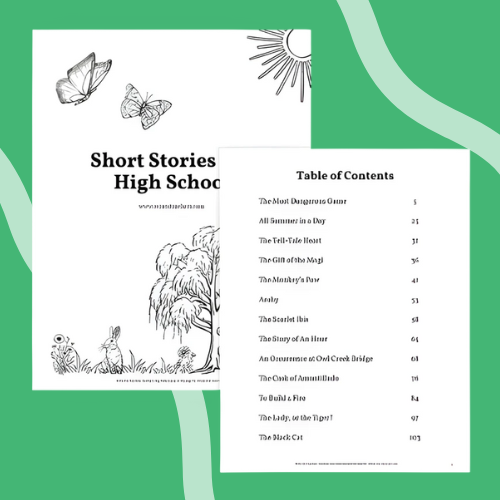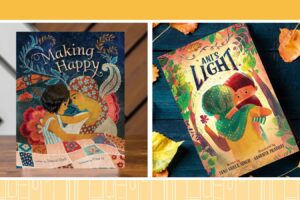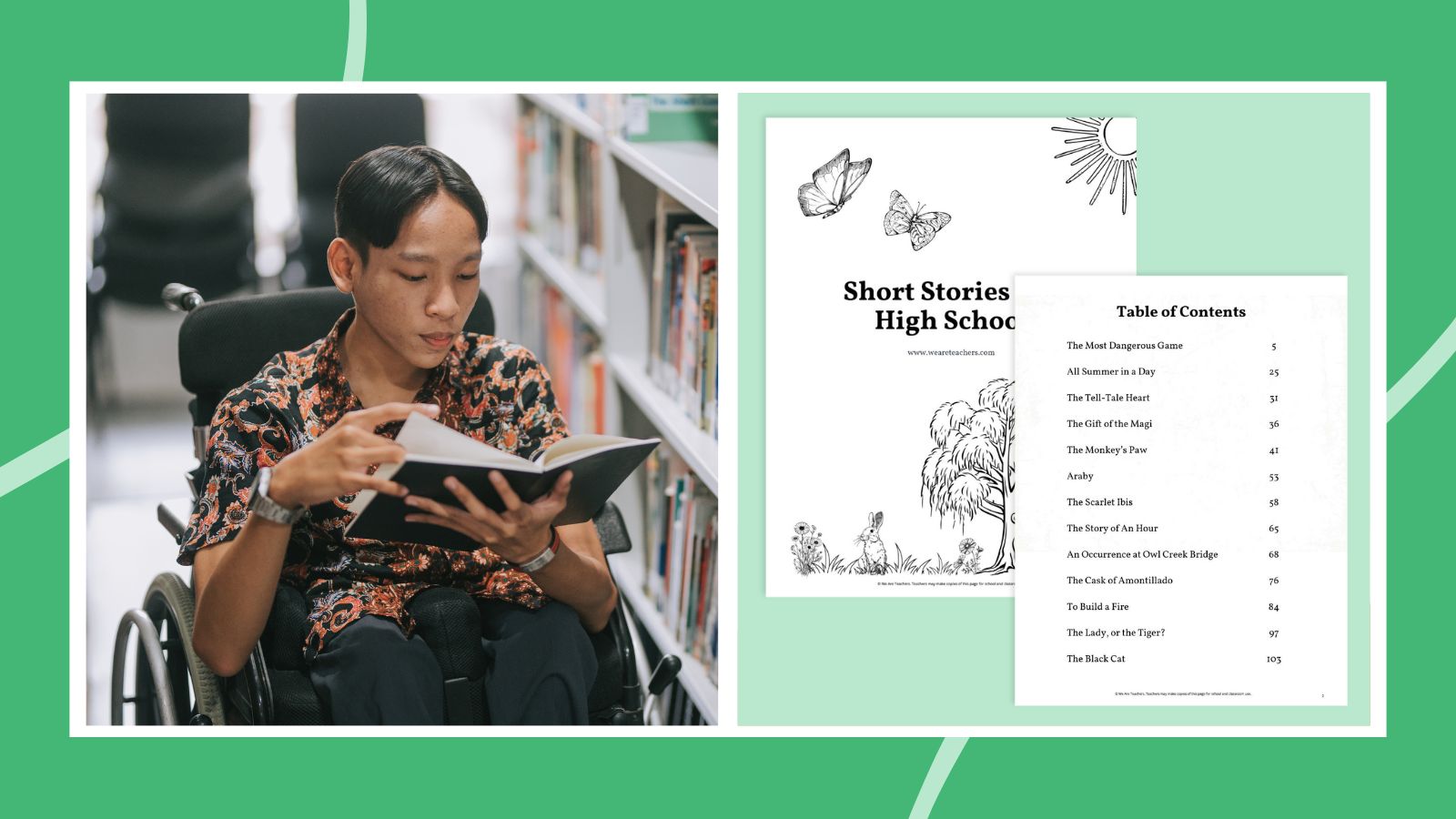
74 Best Short Stories for High School Students (Free Printables)
Short stories are so fun to teach in high school. High schoolers are ready and able to dive deep into text with close reading and analysis. This makes reading and analyzing short stories fun, plus they love to read texts that pack an emotional punch. Use these short stories to teach close reading and literary devices, as mentor texts for writing, and to surprise students and engage them in reading.
1. Lamb to the Slaughter by Roald Dahl
“‘I’ll fix some supper,’ she whispered. When she walked across the room, she couldn’t feel her feet touching the floor. … She went downstairs to the freezer and took hold of the first object she found. She lifted it out and looked at it. It was wrapped in paper, so she took off the paper and looked at it again—a leg of lamb.”
Summary: Lamb to the Slaughter is a darkly ironic short story about betrayal, gender roles, stereotypes, and murder. This one is a great story to read any time of year but especially during spooky season.
Why we love it: Students may already know Roald Dahl from Charlie and the Chocolate Factory, Matilda, and other whimsical novels, but this short story will challenge their opinion of the author. Encourage students to analyze the dramatic irony and discuss: Who is the innocent lamb in this story?
2. The Most Dangerous Game by Richard Connell
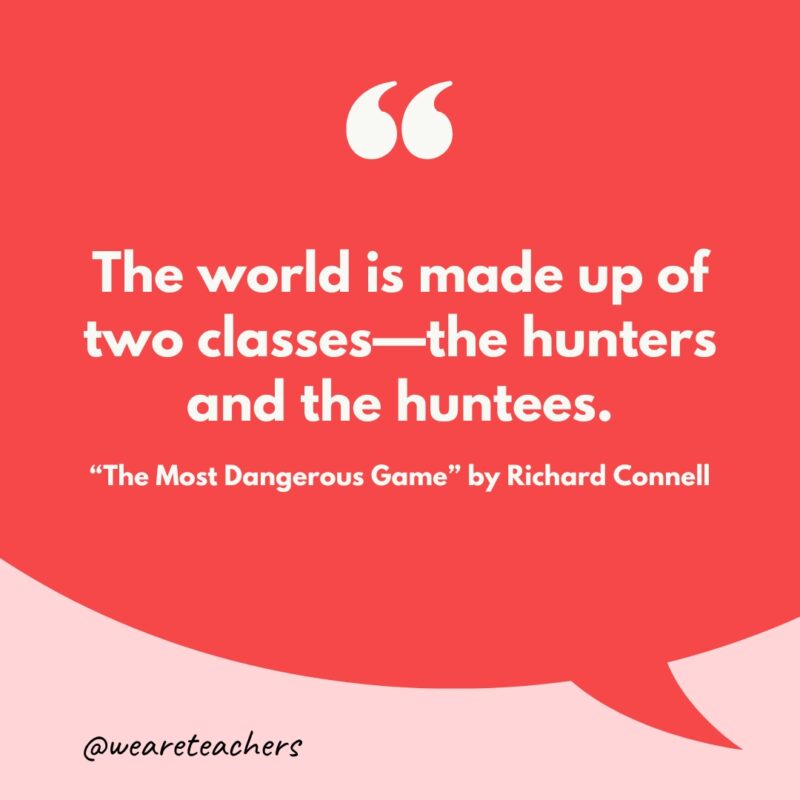
Summary: The Most Dangerous Game takes students on a voyage that lands them on Ship-Trap Island with a madman who loves to hunt. There is only one way off the island. …
Why we love it: This is one of those short stories for high school that engages all students. Ask them: What is the most dangerous game in the world? Then, do a close reading of this story to figure out what’s happening as the story unfolds.
3. The Landlady by Roald Dahl
“‘I stuff all my little pets myself when they pass away. Will you have another cup of tea?’”
Summary: A young traveling gentleman is looking for lodging. He ends up settling on a bed-and-breakfast that looks quite charming from the outside. Unfortunately for him, looks can be deceiving.
Why we love it: This story is great for suspense, irony, and characterization. It always creeps students out.
4. All Summer in a Day by Ray Bradbury
“I think the sun is a flower, that blooms for just one hour.”
Summary: A group of children living on Venus cruelly lock away a classmate who remembers the sun, only to miss its brief appearance after years of endless rain. I get so sad when I teach this story thinking about that little girl.
Why we love it: This story is heartbreaking and truth-telling. Bradbury takes us to Venus and uses the setting to drive the conflict and focus on the character’s behavior.
5. The Veldt by Ray Bradbury
“Too much of anything isn’t good for anyone.”
Summary: Two children become so obsessed with their high-tech nursery that they use its virtual African savanna to murder their parents when they threaten to shut it down.
Why we love it: It’s a dystopian story about the power of technology in our lives. Need we say more? Read this story to start a discussion about technology in our lives, how fiction writing connects with real life, and how science fiction in particular can feel prophetic.
6. The Lottery by Shirley Jackson
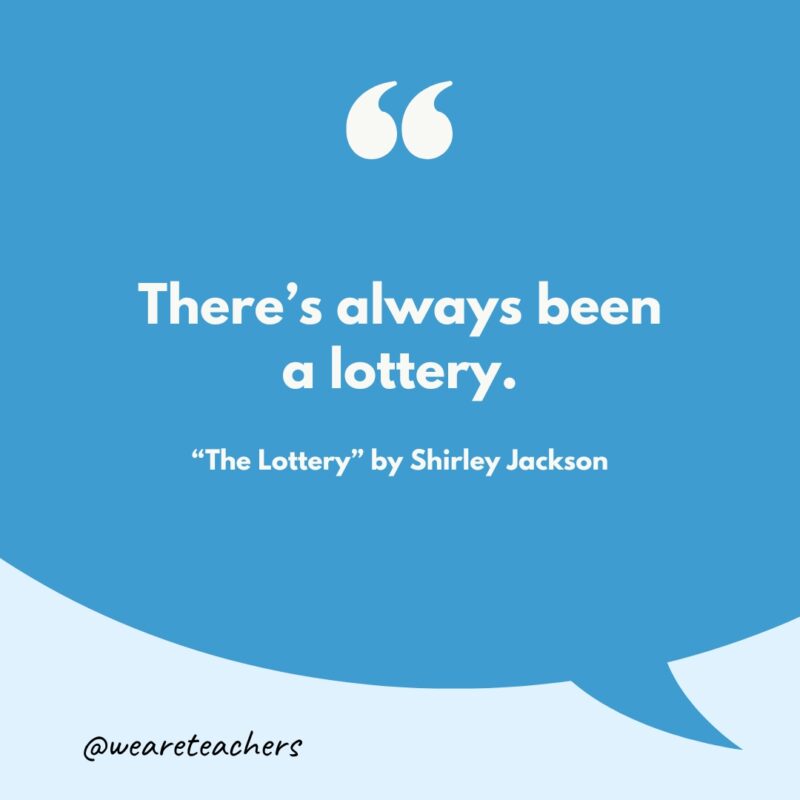
Summary: In this classic short story by Shirley Jackson, readers are taken to a small, quite ordinary village that practices a brutal ritual each year. The villagers seem to be blind to their cruelty and the danger of this tradition.
Why we love it: The brutality of this story sneaks up on you. For a while, you’re convinced this town is ordinary… until you find out the dark consequences of blindly following tradition. This is a must-read for high schoolers. Rereading it will offer a new perspective to reflect on and discuss.
7. The Tell-Tale Heart by Edgar Allan Poe
“It is impossible to say how first the idea entered my brain; but once conceived, it haunted me day and night.”
Summary: In this story from the master of the macabre, an unreliable narrator insists on his sanity while confessing to murdering an old man and being driven to reveal the crime by the imagined sound of the victim’s beating heart.
Why we love it: My students love a murder mystery. This one is made even more alluring while the narrator tries to convince the readers of his sanity.
8. The Gift of the Magi by O. Henry
“One dollar and eighty-seven cents. That was all. And sixty cents of it was in pennies. Pennies saved one and two at a time by bulldozing the grocer and the vegetable man and the butcher until one’s cheeks burned with the silent imputation of parsimony that such close dealing implied. Three times Della counted it. One dollar and eighty-seven cents. And the next day would be Christmas.”
Summary: A young couple sacrifices their most prized possessions to buy each other meaningful Christmas gifts, only to discover the irony that their presents are now useless. But their love is priceless.
Why we love it: The story starts in a shabby apartment on Christmas Eve and works up to themes of inner worth, love, and the subjective value that we place on objects.
9. The Monkey’s Paw by W.W. Jacobs
“’Never mind, dear,’ said his wife soothingly; ‘perhaps you’ll win the next one.’”
Summary: The Monkey’s Paw is a short story about a magical talisman that grants three wishes. But the wishes bring tragic consequences with them.
Why we love it: One of the classic short stories for high school about what can go wrong when granted three wishes. Students also love to know that there was a Simpsons episode based on this short story.
10. The Hanging Stranger by Philip K. Dick
“Again he made a U-turn and brought his car around. He passed the park and concentrated on the dark bundle. It wasn’t a dummy. And if it was a display, it was a strange kind. The hackles on his neck rose and he swallowed uneasily. Sweat slid out on his face and hands. It was a body. A human body.”
Summary: A man discovers a corpse hanging in his town and realizes, to his horror, that everyone else is disturbingly indifferent—uncovering a sinister alien invasion that has secretly taken control of humanity.
Why we love it: An average television repairman finds a dead body and a mystery ensues. This story is best read with some historical context (lynchings were common) and people were living in an age of conformity. But with context, students can understand this story as one of resistance against capitalism.
11. The Ones Who Walk Away From Omelas by Ursula K. Le Guin
“This is the treason of the artist: a refusal to admit the banality of evil and the terrible boredom of pain.”
Summary: A utopian city’s happiness depends on the eternal misery of a single child, prompting some people to walk away in silent protest rather than accept joy that was built on suffering.
Why we love it: In a much-praised story, students read about a utopia built on others’ suffering and grapple with the question if they, too, would walk away from happiness.
12. Araby by James Joyce
“Her name sprang to my lips at moments in strange prayers and praises which I myself did not understand. My eyes were often full of tears (I could not tell why) and at times a flood from my heart seemed to pour itself out into my bosom. I thought little of the future. I did not know whether I would ever speak to her or not or, if I spoke to her, how I could tell her of my confused adoration.”
Summary: Driven by infatuation, a young boy sees an opportunity to win a girl’s heart by attending a bazaar, only to experience a heartbreaking awakening about love and the emptiness of his romantic ideals.
Why we love it: It’s about growing up and developing a crush that is all-consuming, something that high schoolers can surely relate to.
13. A Sound of Thunder by Ray Bradbury
“It fell to the floor, an exquisite thing, a small thing that could upset balances and knock down a line of small dominoes and then big dominoes and then gigantic dominoes, all down the years across Time. Eckels’ mind whirled. It couldn’t change things. Killing one butterfly couldn’t be that important! Could it?”
Summary: A wealthy client named Eckels pays to travel to the past to hunt a Tyrannosaurus rex, but panics and steps off a floating path, killing a butterfly in the process. When he returns to the present, the world has changed. This story illustrates the concept of the butterfly effect.
Why we love it: It’s a short story about the butterfly effect. The plot asks the question many have asked before: If we could travel back in time, how would it change the future?
14. Two Kinds by Amy Tan
“My mother believed you could be anything you wanted to be in America.”
Summary: Two Kinds is a short story from Amy Tan’s book The Joy Luck Club. The story is about a young American girl born to Chinese parents whose mother pushes her to become a child prodigy. But the daughter resists.
Why we love it: It explores the complex mother-daughter relationship.
15. Rules of the Game by Amy Tan
“Next time win more, lose less.”
Summary: Rules of the Game is one of the most popular stories from Amy Tan’s book The Joy Luck Club. The story is about an 8-year-old Chinese American girl who teaches herself chess and becomes a child prodigy, winning many national tournaments. But Rules of the Game is also, like many stories in The Joy Luck Club, about a daughter’s challenging relationship with her mother.
Why we love it: Use this as an example of extended metaphor and as an examination of the mother-daughter relationship.
16. The Scarlet Ibis by James Hurst

Summary: A boy recounts how his pride led him to push his disabled younger brother, Doodle, beyond his limits—ultimately resulting in tragic consequences and deep regret.
Why we love it: It’s a beautifully written, heartbreaking story about brothers.
17. A Good Man Is Hard To Find by Flannery O’Connor
“‘It isn’t a soul in this green world of God’s that you can trust,’ she said. ‘And I don’t count nobody out of that, not nobody,’ she repeated, looking at Red Sammy.”
Summary: A family road trip ends in tragedy when they encounter an escaped convict, forcing the manipulative grandmother to confront her own beliefs and morality in a final moment of grace.
Why we love it: It’s a great story for studying characters, their flaws, and their transformation by the end of the story.
18. Ruthless by William de Mille
“When it comes to protecting my property, I make my own laws.”
Summary: A wealthy man casually reveals his cold, self-centered philosophy of life while lounging on his yacht. In doing so, he also reveals his indifference to others’ feelings.
Why we love it: Ruthless is a tale of revenge with unexpected twists and turns.
19. The Story of an Hour by Kate Chopin
“When the doctors came they said she had died of heart disease—of joy that kills.”
Summary: Louise Mallard learns that her husband has died and, after an initial wave of grief, feels an overwhelming sense of freedom at the thought of living life for herself. Her joy is cut short when her husband walks in alive, and she dies from the shock.
Why we love it: This 19th-century story about love and loss makes students ponder the question: Can a person die of a broken heart?
20. Eleven by Sandra Cisneros
“What they don’t understand about birthdays, and what they’ll never tell you, is that when you’re eleven, you’re also ten, and nine, and eight, and seven, and six, and five, and four, and three, and two, and one.”
Summary: A young girl named Rachel feels small and powerless when her teacher forces her to wear an ugly red sweater that isn’t hers. The story shows how, even at 11, she still carries the feelings of all her younger ages, wishing she could be older and braver in that moment. Even adults can relate to the feeling of wishing we could have been braver in certain moments.
Why we love it: I use this when I teach creative writing. What changes when we turn 11? How are we different from when we were 10? Those middle school years seem to be packed with emotion and significant change.
21. The Test by Theodore Thomas
“Nobody should want to drive a car after going through what you just went through.”
Summary: A man takes a government driving test that unexpectedly turns into a psychological experiment designed to measure his emotional stability. When he fails by showing too much distress at a staged accident, his memory is erased, revealing a chillingly controlled society.
Why we love it: Your students will not see the ending coming.
22. There Will Come Soft Rains by Ray Bradbury
“And one voice, with sublime disregard for the situation, read poetry … until all the film spools burned, until all the wires withered and the circuits cracked.”
Summary: An automated house continues its daily routines after humanity has been wiped out by nuclear war. Eventually, the house is destroyed in a fire, leaving only silence as nature endures without people.
Why we love it: Use this futuristic story to teach setting, foreshadowing, and theme.
23. The Schoolmistress by Anton Chekhov
“‘It is beyond all understanding,’ she thought, ‘why God gives beauty, this graciousness, and sad, sweet eyes to weak, unlucky, useless people—why they are so charming.’”
Summary: A weary teacher travels home after a long day, reflecting on her struggles, poverty, and unfulfilled dreams. Her journey highlights the loneliness and quiet despair of her life, revealing the hardships faced by those devoted to thankless work.
Why we love it: We get to see simple moments become symbols for larger happenings in her life.
24. Lob’s Girl by Joan Aiken
“Some people choose their dogs, and some dogs choose their people.”
Summary: A devoted dog repeatedly runs away from his owners to be with a girl named Sandy, showing their deep bond. After Sandy is hit by a truck and badly injured, Lob miraculously arrives to save her, with sad consequences for himself.
Why we love it: Hook students who love a good story about a dog and its owner and read it for a tale of friendship paired with elements of suspense.
25. An Occurrence at Owl Creek Bridge by Ambrose Bierce
“He had power only to feel, and feeling was torment.”
Summary: A Confederate sympathizer is about to be hanged from a bridge by Union soldiers. He seemingly escapes and runs home to his family, but the entire escape is revealed to be a hallucination in the moments before his death.
Why we love it: Students will be sucked into the narrative by the title alone. And they’ll be shocked by the ending.
26. The Chaser by John Collier
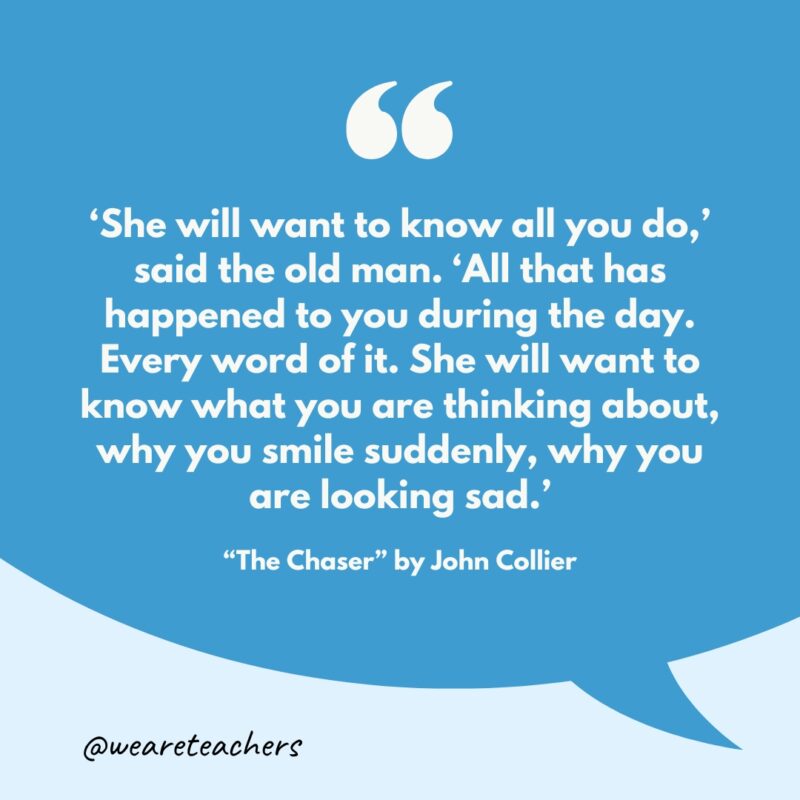
Summary: A young man named Alan buys a cheap love potion to make a woman fall for him, ignoring the old seller’s hints about its troubling permanence. The seller also offers a far more expensive “chaser,” a poison, suggesting Alan will one day want an escape from the very love he seeks.
Why we love it: After you read this story, students can discuss what they would be willing to do for love. Bonus: Pair with a Twilight Zone episode.
27. The Janitor in Space by Amber Sparks
“She feels at home beyond the skies. She lied and said she came here to be close to God, but she feels further away from Him than ever.”
Summary: A lonely janitor working on a space station cleans up after others while quietly yearning for connection and recognition. Her story reflects themes of isolation, invisibility, and the small, often overlooked lives that persist even in extraordinary places.
Why we love it: The creative plot created in this story encourages deep discussion after reading.
28. Standard Loneliness Package by Charles Yu
“Root canal is one fifty, give or take, depending on who’s doing it to you. A migraine is two hundred.”
Summary: In Charles Yu’s Standard Loneliness Package, workers in India are paid to absorb the painful emotions of wealthy clients, experiencing their heartbreak, grief, and suffering on their behalf. The narrator, who endures others’ sadness daily, longs for genuine human connection in a world where feelings can be outsourced. Stories like this are brilliant for discussion. How often have we wanted to just get rid of feelings that feel too heavy to carry? What would we do to eliminate that feeling?
Why we love it: The plot is intriguing enough for students to be invested. Imagine a world where you outsource negative feelings and experiences to other people.
29. The Yellow Wallpaper by Charlotte Perkins Gilman
“I cry at nothing, and cry most of the time.”
Summary: A woman suffering from postpartum depression is confined to a room by her physician husband, who prescribes rest and forbids her from working or writing. As her isolation deepens, she becomes obsessed with the room’s yellow wallpaper, believing she sees a trapped woman within it. Her grip on reality unravels and she identifies herself with the figure, symbolizing her descent into madness and rebellion against oppression.
Why we love it: I still remember the first time I read this story in high school and the discussion about women, mental health, and symbolism.
30. A Jury of Her Peers by Susan Glaspell
“‘Oh, well,’ said Mrs. Hale’s husband, with good-natured superiority, ‘women are used to worrying over trifles.’”
Summary: In A Jury of Her Peers, we are taken back to a time when women really had no rights. One woman in particular was without any freedom and married to an angry man. The man is murdered. This story involves men and their wives as they seek to solve the crime, determining the motive and the method, and before the story is over, it is the women who crack the case.
Why we love it: It’s a story about women being misunderstood and underestimated, a theme that still resonates today.
31. The Cask of Amontillado by Edgar Allan Poe
“‘The cough is a mere nothing; it will not kill me. I shall not die of a cough.’
‘True—true,’ I replied.”
Summary: In Poe’s The Cask of Amontillado, Montresor lures his unsuspecting acquaintance Fortunato into the catacombs with the promise of rare wine. Once deep inside, Montresor chains him to a wall and seals him behind bricks, leaving him to die as an act of revenge.
Why we love it: It’s a revenge story whose primary literary device is irony.
32. To Build a Fire by Jack London
“He now received the full force of the cold. The blood of his body drew back from it. The blood was alive, like the dog.”
Summary: An inexperienced man travels alone through the Yukon wilderness despite warnings about the deadly cold. After a series of failed attempts to build a fire, he succumbs to the freezing temperatures, while his dog survives and instinctively seeks safety.
Why we love it: Jack London’s work is true American literature, with adventure stories told in expansive wilderness. This story has all the elements for a great adventure story and will capture students’ attention from the first line.
33. The Sniper by Liam O’Flaherty
![50 Best Short Stories for High School Students “[The sniper's eyes] were deep and thoughtful, the eyes of a man who is used to looking at death.”](https://www.weareteachers.com/wp-content/uploads/Short-Story-Quotes-HS-6-800x800.jpg)
Summary: A sniper in the Irish Civil War kills an enemy soldier after a tense rooftop battle. When he turns the body over, he is horrified to discover that the enemy is his own brother, highlighting the personal tragedy of war.
Why we love it: It’s a story that illustrates the pain and loss of war.
34. The Lady, or the Tiger? by Frank Stockton
“It mattered not that he might already possess a wife and family, or that his affections might be engaged upon an object of his own selection; the king allowed no such subordinate arrangements to interfere with his great scheme of retribution and reward.”
Summary: A young man accused of loving a princess must choose between two doors: One hides a beautiful lady he must marry and the other a fierce tiger that will kill him. The story ends ambiguously, leaving readers to wonder whether the jealous princess guided him to love or death.
Why we love it: This story has a clear cause-and-effect structure that you can use to show how actions have consequences.
35. The Black Cat by Edgar Allan Poe
“Yet, mad I am not—and very surely do I not dream.”
Summary: In this Poe short story, a man descends into alcoholism and madness, abusing his beloved pets and eventually murdering his wife in a fit of rage. His guilt manifests through a haunting black cat that ultimately leads the police to discover his crime.
Why we love it: This is one of the classic Poe short stories for high school about madness. It’s a good one to use to introduce students to classic short stories or to Edgar Allan Poe.
Learn more: 25 Popular Edgar Allan Poe Poems
36. The Celebrated Jumping Frog of Calaveras County by Mark Twain
“Smiley said all a frog wanted was education, and he could do ‘most anything’—and I believe him.”
Summary: A man recounts a humorous tale about Jim Smiley, a gambler who would bet on anything, including his trained frog’s jumping ability. Smiley is outwitted when a stranger secretly fills the frog with buckshot, causing it to lose the contest and leaving Smiley cheated.
Why we love it: A Mark Twain story about a man who bets on anything—use this next time a student says “Bet!” to you.
“One morning, when Gregor Samsa woke from troubled
dreams, he found himself transformed in his bed into a horrible vermin.”
Summary: A traveling salesman wakes up one morning to find himself transformed into a giant insect. As his family grows increasingly horrified and burdened by him, Gregor is neglected and eventually dies, symbolizing alienation and the loss of human connection.
Why we love it: Read this story for symbolism, as the main character turns into an insect overnight. It’s an excellent story that illustrates alienation and loneliness.
38. Young Goodman Brown by Nathaniel Hawthorne
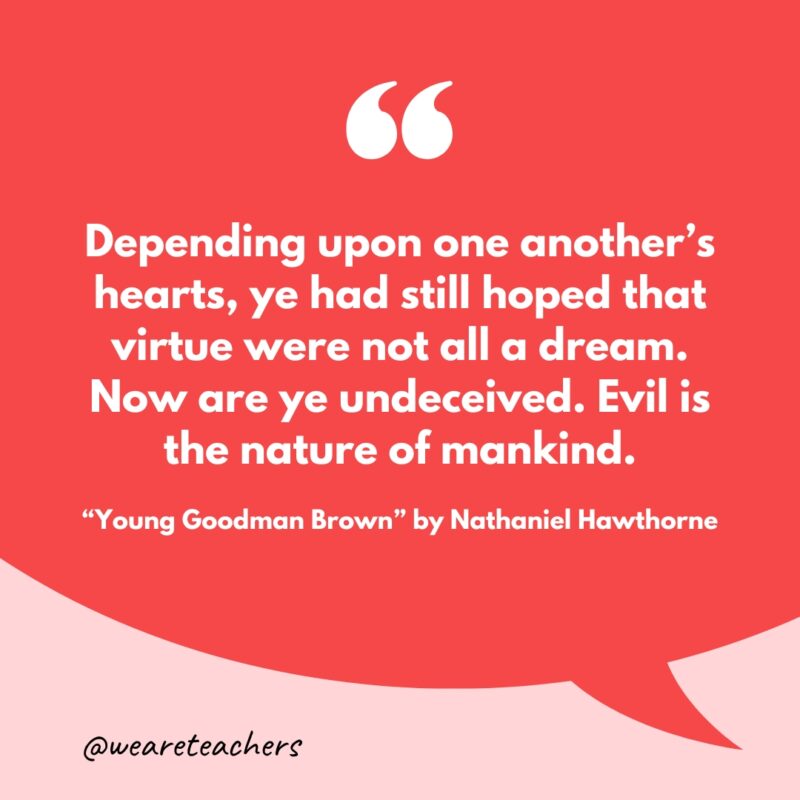
Summary: A man ventures into the forest at night and witnesses—or dreams of witnessing—a satanic gathering that includes respected members of his community and even his wife. Shaken and disillusioned, he loses faith in others and lives the rest of his life in gloom and mistrust.
Why we love it: A great American literature read that explores the nature of humanity and questions of faith.
39. Through the Tunnel by Doris Lessing
“They were of that coast; all of them were burned smooth dark brown and speaking a language he did not understand. To be with them, of them, was a craving that filled his whole body.”
Summary: A young man pushes himself to swim through an underwater tunnel to prove his independence and maturity. Although dangerous, he succeeds and no longer feels the need to impress others, marking his journey to adulthood
Why we love it: The story focuses on overcoming limitations, with an 11-year-old who trains to swim through an underwater hole in a rock. It is rich in symbolism and beautifully illustrates the transition from childhood to adulthood.
40. The Ice Palace by F. Scott Fitzgerald
“Up in her bedroom window Sally Carrol Happer rested her nineteen-year-old chin on a fifty-two-year-old sill and watched Clark Darrow’s ancient Ford turn the corner.”
Summary: A Southern woman visits her fiancé’s cold Northern hometown, hoping to embrace a new life. Overwhelmed by the harsh climate and alien culture, she realizes she cannot leave behind her Southern roots and returns home disillusioned.
Why we love it: Fitzgerald was gifted in writing about tension in love. This story is about the tension between lovers from the North and South. Read it for the story and the poetic language of Fitzgerald.
41. Birthday Party by Katharine Brush
“There was nothing conspicuous about them, nothing particularly noticeable, until the end of their meal, when it suddenly became obvious that this was an Occasion—in fact, the husband’s birthday, and the wife had planned a little surprise for him.”
Summary: In Birthday Party, a woman surprises her husband with a small birthday celebration at a restaurant, complete with a cake and candles. Instead of being pleased, he is embarrassed and irritated, leaving her hurt and highlighting the quiet pain of unmet affection.
Why we love it: This is a very quick read and manages to pack a punch in a small number of words.
42. Thank You, Ma’am by Langston Hughes
“You ought to be my son. I would teach you right from wrong.”
Summary: A young boy is caught trying to steal a woman’s purse. But instead of punishing him, the woman shows him kindness and trust, teaching him a powerful lesson about compassion and respect.
Why we love it: The story is relatable and sends an important message about compassion and second chances.
43. Girl by Jamaica Kincaid

Summary: In Jamaica Kincaid’s Girl, a mother delivers a long, urgent monologue of advice, warnings, and commands to her daughter about how to behave and survive as a woman in society. Beneath the instructions, there is tension between guidance and control, revealing the weight of expectations placed on girls.
Why we love it: It’s a message from a mother to a daughter on how to behave.
44. The Pie by Gary Soto
“Once, at the German Market, I stood before a rack of pies, my sweet tooth gleaming and the juice of guilt wetting my underarms. I nearly wept.”
Summary: A young boy steals a pie from a store, eats it, and then is consumed by guilt and the fear of being caught. Through his inner conflict, the story explores themes of temptation, morality, and childhood conscience.
Why we love it: This is one of the best short stories for high school students about the strength and power of guilt.
45. Sticks by George Saunders
“The pole was Dad’s only concession to glee.”
Summary: A boy recalls his father’s harshness and the strict rules that shaped his childhood. The story highlights the emotional distance between them, showing how discipline and control overshadow warmth and affection in their relationship.
Why we love it: This super-short story is about a father’s tradition of decorating a pole in the yard and all that the pole represents.
46. Marigolds by Eugenia Collier
“For one does not have to be ignorant and poor to find that one’s life is barren as the dusty yards of our town.”
Summary: A young girl, frustrated by poverty and growing pains, destroys her neighbor Miss Lottie’s beautiful marigolds in a fit of anger. She later regrets her actions, realizing it was her loss of innocence and the beginning of her understanding of compassion.
Why we love it: This is a story about realizing that we’re growing up. It’s a great story that students will immediately relate to.
47. The Pedestrian by Ray Bradbury
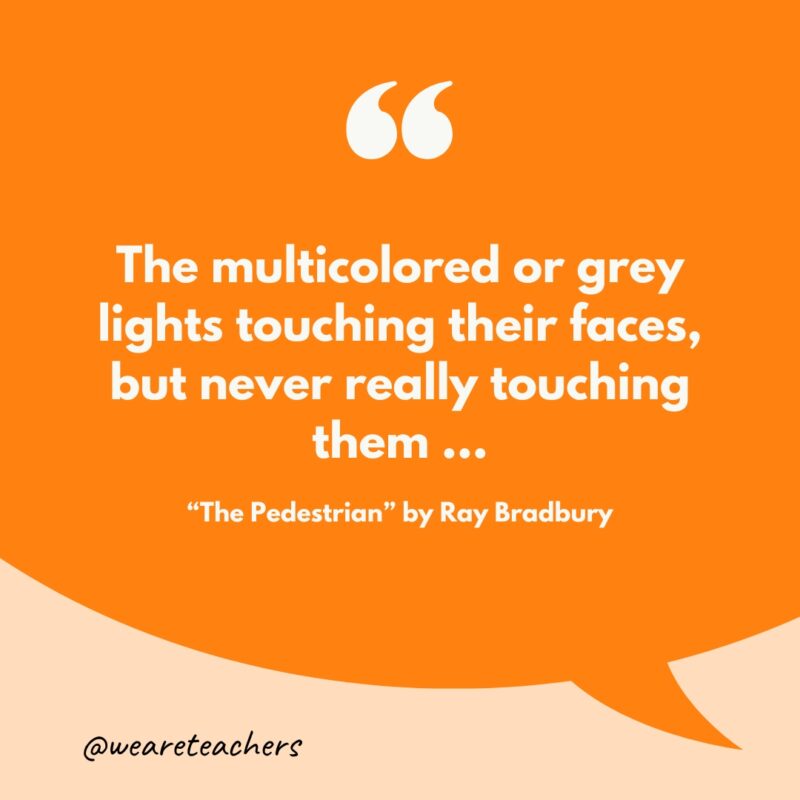
Summary: A man takes nightly walks in a future society where people stay indoors absorbed by their televisions. One evening, he is stopped by a robotic police car and taken away for his unusual behavior, revealing the dangers of conformity and technological control.
Why we love it: This story takes place in 2053, and Ray Bradbury has a way of making the future feel like the present. In a story written long ago, he reminds us how important it is to not lose our humanity.
48. The Stolen Party by Liliana Heker
“She was so pleased with the compliment that a while later, when her mother came to fetch her, that was the first thing she told her.”
Summary: A girl excitedly attends her wealthy friend Luciana’s birthday party, believing she is a true guest. By the end, she realizes she was only seen as a servant, highlighting the painful divide between social classes.
Why we love it: This story lets us view a party through a child’s eyes and a mother’s desire to protect her daughter’s heart.
49. The Wretched and the Beautiful by E. Lily Yu
“‘Come out where we can see you,’ the policeman said. The rest of us were glad that someone confident and capable, someone who was not us, was handling the matter.”
Summary: When alien refugees arrive on Earth seeking safety, humanity’s compassion is tested as fear, prejudice, and selfishness clash with empathy and generosity. The story explores how people respond to vulnerability and differences, questioning whether kindness can overcome suspicion.
Why we love it: While this story involves aliens, it asks readers to think about what it means to be human. There is also great symbolism in this story.
50. Cooking Time by Anita Roy
“At that moment, all I felt was angry. I’d always known that Mandy’s obsession would get us into trouble. But would she listen? Never.”
Summary: A young woman joins a futuristic reality show where contestants relive the experience of cooking real food in a world that now only consumes artificial meals. As she immerses herself in the sensory joy of cooking, she begins to question society’s disconnection from tradition, memory, and authenticity.
Why we love it: This is a story that is set in a dystopian future where the food has been replaced by a supplement. It’s a unique take on a dystopian world as it involves a cooking show and trying to change the way the world operates.
51. He — Y, Come On Ou — t! by Shinichi Hoshi, translated by Stanleigh Jones
“Whatever one wished to discard, the hole accepted it all. The hole cleansed the city of its filth.”
Summary: Villagers discover a mysterious hole and use it as a dumping ground for all their waste, from trash to dangerous materials. In the end, their carelessness is revealed when the hole’s contents begin to fall back from the sky, showing the consequences of ignoring responsibility.
Why we love it: This is a story about a Japanese village discovering a mysterious hole that illustrates what happens when people behave selfishly.
52. Désirée’s Baby by Kate Chopin
“It made her laugh to think of Désirée with a baby. Why, it seemed but yesterday that Désirée was little more than a baby herself; when Monsieur in riding through the gateway of Valmondé had found her lying asleep in the shadow of the big stone pillar.”
Summary: Rejected by her husband after their child shows signs of mixed race, a mother disappears with her baby in despair. Later, the husband discovers it was his own family line that carried African ancestry, not Désirée’s, revealing the irony and cruelty of his prejudice.
Why we love it: Chopin is known for humor, but this story has a serious subject. The main character is raised on a rural plantation in pre–Civil War Louisiana. But when she grows up and has a child of her own, her background becomes problematic. This story grapples with the hypocrisy and exploitation in societies built on racial discrimination.
53. Eraser Tattoo by Jason Reynolds
“Love hurts, but we cool with it.”
Summary: Childhood friends Shay and Dante share a tender moment on the day Shay is moving away, as Dante gives her an “eraser tattoo” on her arm. The playful yet painful act symbolizes both their deep bond and the ache of growing up and being separated.
Why we love it: High schoolers can relate to young love. My high school students love Jason Reynolds’ writing and also love a coming-of-age romance.
54. Hills Like White Elephants by Ernest Hemingway
“The hills across the valley of the Ebro were long and white. On this side there was no shade and no trees and the station was between two lines of rails in the sun.”
Summary: Trigger warning: This story is about abortion and may not be a story you want to read in your secondary ELA class. An American man and a woman wait for a train in Spain while discussing, in tense and indirect dialogue, whether she should have an abortion. The unspoken conflict between them highlights themes of communication, choice, and the strain in their relationship.
Why we love it: Hemingway is another must-read for students. In this story, even the setting, a railroad station, has significance. The story is also a study in contrasts, with white hills and the barren valley representing life and death. One thing to know before sharing with your class: This is a story that involves a woman thinking about whether or not to have an abortion.
55. The Diamond Necklace by Guy de Maupassant
“The girl was one of those pretty and charming young creatures who sometimes are born, as if by a slip of fate, into a family of clerks. She had no dowry, no expectations, no way of being known, understood, loved, married by any rich and distinguished man; so she let herself be married to a little clerk of the Ministry of Public Instruction.”
Summary: A woman borrows a beautiful necklace to attend a ball, only to lose it and spend years in poverty repaying the debt for a replacement. In the end, she learns the original necklace was a worthless imitation, making her sacrifice tragically pointless.
Why we love it: The main character chases material possessions but learns a hard lesson through misfortune. This story showcases the short story form at its best while giving students a glimpse into 19th-century life.
56. The Oval Portrait by Edgar Allan Poe
“Long, long I read—and devoutly, devotedly I gazed. Rapidly and gloriously the hours flew by and the deep midnight came. The position of the candelabrum displeased me, and outreaching my hand with difficulty, rather than disturb my slumbering valet, I placed it so as to throw its rays more fully upon the book.”
Summary: A wounded man takes refuge in an abandoned chateau and grows fascinated by a lifelike painting of a young woman. He soon learns that the painter became so consumed with capturing her image that he let her waste away, and she died just as he finished the portrait.
Why we love it: Poe never disappoints. This story delivers his signature gothic gloom—macabre imagery, a delirious narrator, and chilling suspense. It’s perfect as extra reading for students who already love Poe or who crave a darker suspenseful tale.
57. The Eyes Have It by Philip K. Dick
“It was quite by accident I discovered this incredible invasion of Earth by lifeforms from another planet. As yet, I haven’t done anything about it; I can’t think of anything to do.”
Summary: A man becomes convinced that aliens live among humans after misinterpreting common idioms like “her eyes followed him across the room.” His paranoia grows absurd as he takes figurative language literally, turning a simple reading experience into a comical misunderstanding.
Why we love it: Dick imagines what it would be like if aliens invaded Earth, but no one listened. The story has language that shows how weird English can be when taken literally.
58. Markheim by Robert Louis Stevenson
“‘Yes,’ said the dealer, ‘our windfalls are of various kinds. Some customers are ignorant, and then I touch a dividend on my superior knowledge. Some are dishonest,’ and here he held up the candle, so that the light fell strongly on his visitor, ‘and in that case,’ he continued, ‘I profit by my virtue.’”
Summary: Markheim murders a shop dealer during a robbery, only to face a mysterious, possibly supernatural visitor who confronts him with his guilt and corruption. In the end, Markheim chooses confession over escape, exposing his struggle between sin and redemption.
Why we love it: Like much of Stevenson’s work, Markheim dives deep into the clash between good and evil—giving students plenty to analyze and debate.
59. The Triumph of Night by Edith Wharton
“It was clear that the sleigh from Weymore had not come; and the shivering young traveller from Boston, who had so confidently counted on jumping into it when he left the train at Northridge Junction, found himself standing alone on the open platform, exposed to the full assault of night-fall and winter.”
Summary: A young man traveling in New England seeks shelter in a wealthy man’s house, where he encounters a chilling ghostly apparition. The vision reveals a dark truth about greed and betrayal, suggesting that evil and corruption persist beyond death.
Why we love it: This story is a mystery with supernatural elements. It’s not a horror story, but Wharton uses characterization to analyze motives and describe the supernatural elements in sparse language that will require students to use their imagination.
60. A Descent Into the Maelstrom by Edgar Allan Poe
“In truth so deeply was I excited by the perilous position of my companion, that I fell at full length upon the ground, clung to the shrubs around me, and dared not even glance upward at the sky—while I struggled in vain to divest myself of the idea that the very foundations of the mountain were in danger from the fury of the winds.”
Summary: A sailor recounts how he and his brothers were caught in a massive whirlpool off the coast of Norway. By carefully observing the vortex’s patterns, he saves himself by clinging to a floating barrel, though the experience leaves him aged and shaken. However, the community refuses to believe his story.
Why we love it: Well, we love a lot of Edgar Allan Poe’s work. This story takes a natural phenomenon—a maelstrom, or whirlpool—and uses it to create a story that lends itself to multiple interpretations. See how many conclusions students can come to.
61. Heart of Youth by Walter J. Muilenburg
“The boy on the cultivator straightened as the horses walked from the soft, spongy ground of the cornfield to the firmer turf at the side of the road. He spoke sharply to the plodding team and turned the cultivator around, lowering the blades for another row. Then, when the horses had fallen into a slow walk, he slouched down, and with bent head watched the hills of young corn pass beneath him.”
Summary: A farm boy spends a grueling day guiding a cultivator through the fields, the dry air meant to ease his ailing mother’s condition. As he works, his emotions shift—from frustration and fatigue to empathy and resolve—reflecting his struggle to balance growing responsibilities, personal desires, and devotion to family against the backdrop of rural America. This story resonates especially with students from farm communities.
Why we love it: On the surface, it’s a simple story about a teenage boy. Yet it also captures life in the early 1900s and explores themes—family, responsibility, and identity—that students can still connect with today.
62. How the Widow Won the Deacon by William James Lampton
“Of course the Widow Stimson never tried to win Deacon Hawkins, nor any other man for that matter. A widow doesn’t have to try to win a man; she wins without trying.”
Summary: A gossipy sewing circle speculates about a widow and her neighbor after the deacon unexpectedly brings her to their meeting by sleigh. When he races a rival, the widow suddenly leaps into a snowdrift—not to escape, but to lighten the sleigh and help him win. Her bold act turns the deacon’s admiration into something deeper.
Why we love it: In the Victorian era, women faced limited rights and lost even more through marriage. Lampton flips that expectation by showing a widow who wins over a deacon on her own terms. Drawn from a collection of humorous American short stories, this tale highlights how authors use the short story form to poke fun at society.
63. Antaeus by Frank Bicknell
“I am not sure that it is usual to confer upon steam-rollers the dignity of a name, but my friend had one, and I read it on the neat, black-lettered brass plate affixed to the side of his boiler, near the smoke-stack. This, I take it, was the nearest practicable approach to hanging a locket about his neck that could be managed, and I have always felt grateful to his unknown sponsors for their little act of consideration.”
Summary: A group of boys in a Southern mill town builds a rooftop garden, led by a newcomer who insists on working with real soil. Their project thrives until adults force them to dismantle it, symbolizing the loss of youthful dreams and the clash between imagination and harsh reality.
Why we love it: This story comes from a book of adventure stories and takes place on the American railroad, a wonderful way to talk about plot and symbolism.
64. Why the Sea Is Salt, a Norse Myth
“Once on a time, but it was a long, long time ago, there were two brothers, one rich and one poor. Now, one Christmas Eve, the poor one hadn’t so much as a crumb in the house, either of meat or bread, so he went to his brother to ask him for something to keep Christmas with, in God’s name. It was not the first time his brother had been forced to help him, and you may fancy he wasn’t very glad to see his face.”
Summary: In the Norse myth Why the Sea Is Salt, a poor man receives a magical hand mill that produces anything he wishes. His greedy brother steals it, takes it aboard a ship, and lets it grind salt without stopping. The ship sinks, and the mill keeps turning at the bottom of the sea, which explains why the sea is salty.
Why we love it: Myths and legends reveal how cultures explain the world around them. This Norse tale offers a vivid origin story for the sea and invites students to compare Norse mythology with the stories of other cultures.
65. Daedalus and Icarus by Ferdinand Schmidt
“Daedalus of Athens was a son of Metion, grandson of Erectheus. He was the most skillful man of his time—an architect, sculptor, and stone worker. … But skillful, zealous, and active as he was in his work, he had vices which brought him into trouble.”
Summary: In Schmidt’s retelling of Daedalus and Icarus, the master inventor Daedalus fashions wings of feathers and wax so he and his son can escape imprisonment on Crete. Despite his father’s warnings, Icarus flies too close to the sun, causing the wax to melt and leading to his tragic fall into the sea.
Why we love it: Use short stories to introduce (or reintroduce) high schoolers to myths. If they are familiar with these myths, how does their additional life experience impact their understanding of each story?
66. A Slander by Anton Chekhov
“Vankin’s sincerity did not admit of doubt. It was evidently not he who was the author of the slander.
“‘But who, then, who?’ Ahineev wondered, going over all his acquaintances in his mind and beating himself on the breast. ‘Who then?’
“Who then? We, too, ask the reader.”
Summary: A man at a wedding carelessly whispers a joke that implies the choir director is having an affair with the bride’s mother. The rumor quickly spreads and ruins the innocent man’s reputation, showing how thoughtless words can cause needless harm.
Why we love it: In this story, a schoolmaster is upset when a rumor spreads about him. The topic is totally relatable and will inspire discussion about how some themes change but never die.
67. The Boscombe Valley Mystery by Arthur Conan Doyle
“We were seated at breakfast one morning, my wife and I, when the maid brought in a telegram. It was from Sherlock Holmes and ran in this way: ‘Have you a couple of days to spare? Have just been wired for from the west of England in connection with Boscombe Valley tragedy. Shall be glad if you will come with me. Air and scenery perfect. Leave Paddington by the 11:15.’”
Summary: In Arthur Conan Doyle’s The Boscombe Valley Mystery, Sherlock Holmes investigates the murder of Charles McCarthy after authorities accuse McCarthy’s son of killing him. Holmes uncovers the real killer, who confesses before dying and clears the son of all suspicion.
Why we love it: Sherlock Holmes adventures give students an engaging way to step into the world of detective fiction and explore Arthur Conan Doyle’s mastery of mystery. In this story, Holmes unravels a murder case that pits a father against his estranged son.
68. Bartleby, the Scrivener by Herman Melville
“Imprimis: I am a man who, from his youth upwards, has been filled with a profound conviction that the easiest way of life is the best. Hence, though I belong to a profession proverbially energetic and nervous, even to turbulence, at times, yet nothing of that sort have I ever suffered to invade my peace.”
Summary: In Herman Melville’s Bartleby, the Scrivener, a Wall Street lawyer hires a quiet copyist named Bartleby, who soon begins refusing to take on tasks, simply saying, “I would prefer not to.” As Bartleby withdraws from work and life itself, the lawyer struggles between pity and frustration, until Bartleby dies in prison, embodying themes of isolation and passive resistance.
Why we love it: Many students already know Melville through Moby-Dick, but this story shows a different side of his writing. It follows a clerk who accepts a job and then refuses to do the work, offering students a fresh perspective on Melville’s themes and style.
69. A Warrior’s Daughter by Zitkala-Sa
“In the afternoon shadow of a large tepee, with red-painted smoke lapels, sat a warrior father with crossed shins. His head was so poised that his eye swept easily the vast level land to the eastern horizon line.”
Summary: In Zitkala-Ša’s A Warrior’s Daughter, Tusee, the daughter of a great chief, proves her courage when enemies capture her lover. She disguises herself, infiltrates their camp, and rescues him, showing that men do not hold a monopoly on bravery and strength.
Why we love it: This Native American story highlights Tusee, a woman who takes bold action against an enemy tribe after they capture her love. Zitkala-Ša, a Dakota author, wrote it as both a love story and a celebration of women’s courage.
70. The Adventure of the Speckled Band by Arthur Conan Doyle
“It was early in April in the year ’83 that I woke one morning to find Sherlock Holmes standing, fully dressed, by the side of my bed.”
Summary: In Arthur Conan Doyle’s The Adventure of the Speckled Band, Sherlock Holmes investigates the mysterious death of a young woman who spoke of a “speckled band” before dying. Holmes discovers that her stepfather used a venomous snake to kill her, but his plan to kill his other daughter backfires and the snake kills the stepfather instead.
Why we love it: Another Sherlock Holmes story, in this one, the main character’s twin sister died two years before, but now she fears for her life. Suspenseful!
71. The One Thousand Dozen by Jack London
“David Rasmunsen was a hustler, and, like many a greater man, a man of the one idea. Wherefore, when the clarion call of the North rang on his ear, he conceived an adventure in eggs and bent all his energy to its achievement.”
Summary: A desperate man tries to strike it rich during the Klondike Gold Rush. He hauls 1,000 dozen eggs to Dawson City, believing he can sell them for a fortune. By the time he arrives, the market is oversupplied, and he loses everything. This short story illustrates the risks of greed and speculation.
Why we love it: This story, originally published in 1903, takes a humorous spin on the westward expansion that London loved to write about. A man tries to make money by transporting eggs from San Francisco to Dawson, with the man’s cargo constantly in danger along the way.
72. Hansel and Grethel by the Grimm Brothers
“Once upon a time there dwelt near a large wood a poor woodcutter, with his wife and two children by his former marriage, a little boy called Hansel, and a girl named Grethel.”
Summary: Two siblings are abandoned in the forest and stumble upon a witch’s house made of sweets. The witch captures them and plans to eat them, but they outwit her by shoving her into her own oven. At last, they return home with treasure and save their family from poverty.
Why we love it: High schoolers have the background knowledge to tackle original Grimm brothers fairy tales. Read Hansel and Grethel and discuss: What makes a children’s story? Why might people write such stark stories for kids?
73. The Box of Robbers by L. Frank Baum
“No one intended to leave Martha alone that afternoon, but it happened that everyone was called away, for one reason or another.”
Summary: A curious girl named Martha opens a mysterious box and accidentally releases three Italian bandits. Though the robbers plan to steal from her household, Martha cleverly tricks them back into the box, restoring peace and order.
Why we love it: Students are already familiar with L. Frank Baum’s most famous story, The Wizard of Oz, but Baum also wrote many short stories in his career. Reading lesser-known works by well-known writers gives students a deeper perspective about these personalities.
74. The Willows by Algernon Blackwood
“After leaving Vienna, and long before you come to Buda-Pesth, the Danube enters a region of singular loneliness and desolation, where its waters spread away on all sides regardless of a main channel, and the country becomes a swamp for miles upon miles, covered by a vast sea of low willow-bushes.”
Summary: Two friends canoeing down the Danube River camp on a small island surrounded by eerie willow trees. As strange events unfold, they sense the presence of vast, otherworldly forces, leaving them terrified and powerless before the unknown.
Why we love it: Algernon Blackwood was a prolific writer and well known for his supernatural and ghost stories. The Willows had an impact on other writers like H.P. Lovecraft, who thought it was the finest ghost story in English literature.
Get your free printable short stories for high school!
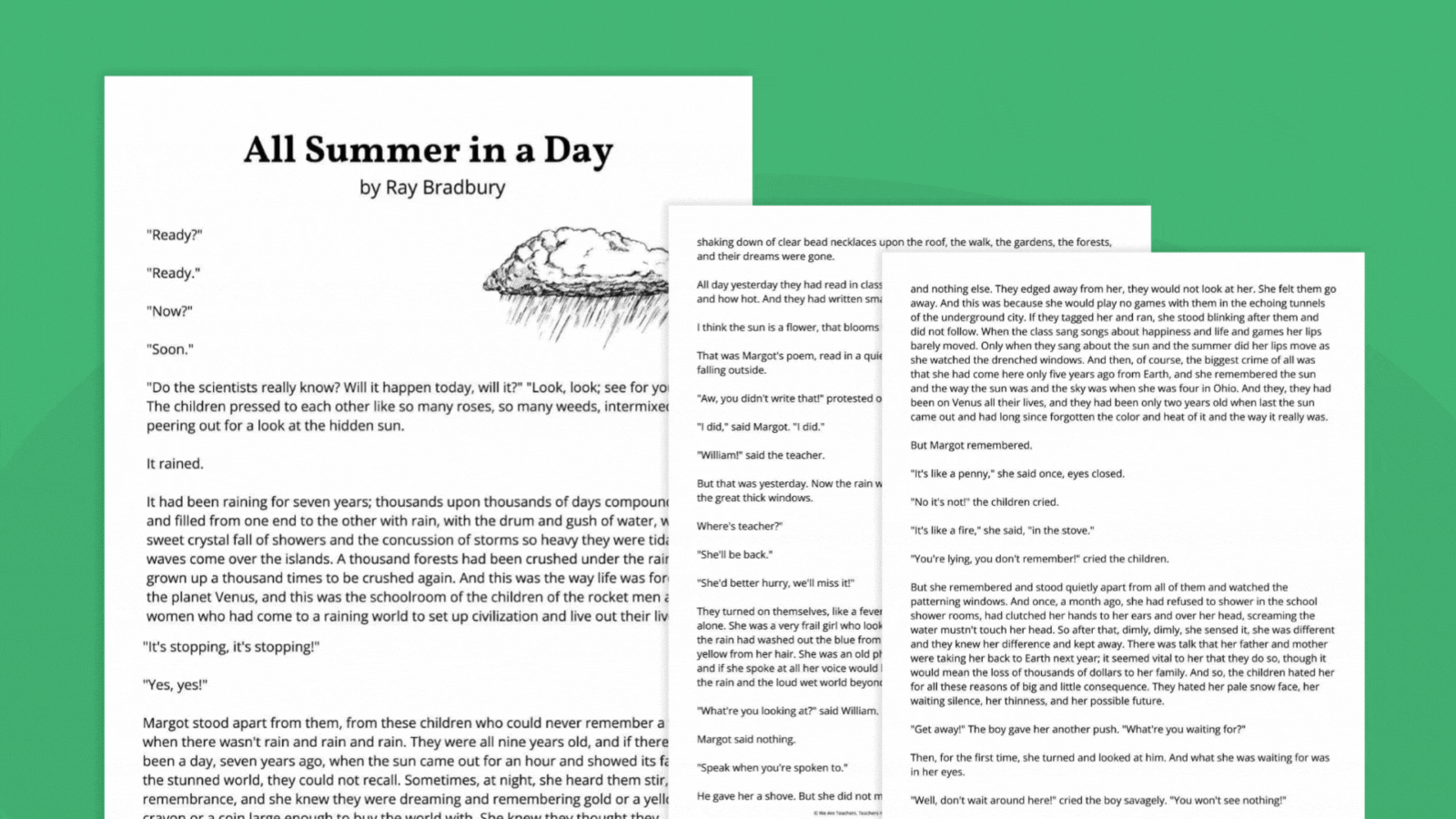
Pass out copies of the short stories pictured above to your high school class. We have included some of our favorite short stories in an easy-to-print format. All you need to do is press the button below to fill out the form and grab your free copies.
Did you enjoy these short stories for high school students? Check out this list of Our All-Time Favorite Classroom Quotes.
For more articles like this, be sure to subscribe to our newsletters to find out when they’re posted!
Source link

